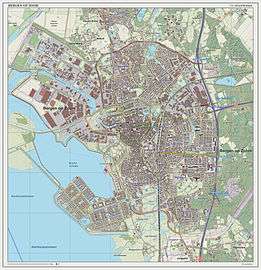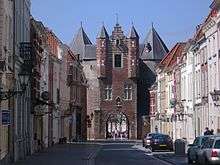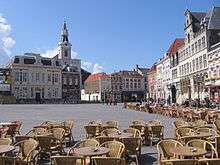Bergen op Zoom
| Bergen op Zoom | |||
|---|---|---|---|
| Municipality | |||
|
Markiezenhof in Bergen op Zoom | |||
| |||
.svg.png) Location in North Brabant | |||
| Coordinates: 51°30′N 4°18′E / 51.500°N 4.300°ECoordinates: 51°30′N 4°18′E / 51.500°N 4.300°E | |||
| Country | Netherlands | ||
| Province | North Brabant | ||
| Government[1] | |||
| • Body | Municipal council | ||
| • Mayor | Frank Petter (CDA) | ||
| Area[2] | |||
| • Total | 93.13 km2 (35.96 sq mi) | ||
| • Land | 80.04 km2 (30.90 sq mi) | ||
| • Water | 13.09 km2 (5.05 sq mi) | ||
| Elevation[3] | 10 m (30 ft) | ||
| Population (May 2014)[4] | |||
| • Total | 66,464 | ||
| • Density | 830/km2 (2,100/sq mi) | ||
| Demonym(s) | Bergenaar | ||
| Time zone | CET (UTC+1) | ||
| • Summer (DST) | CEST (UTC+2) | ||
| Postcode | 4600–4625, 4660–4664 | ||
| Area code | 0164 | ||
| Website |
www | ||

Bergen op Zoom (Dutch pronunciation: [ˈbɛrɣə(n) ɔp ˈsoːm];[5] called Berrege [ˈbɛrəɣə] in the local dialect) is a municipality and a city located in the south of the Netherlands.
Etymology
The city was built on a place where two types of soil meet: sandy soil and marine clay. The sandy soil pushed against the marine clay, accumulating and forming hills over several centuries. People called those hills the Brabantse Wal, literally meaning "wall of Brabant". Zoom refers to the border of this wall and bergen in Dutch means mountains or hills. The name has nothing to do with the little channel the ‘Zoom’ which was later built through Bergen op Zoom.
History
.jpg)
Bergen op Zoom was granted city status probably in 1212. In 1287 the city and its surroundings became a lordship as it was separated from the lordship of Breda. The lordship was elevated to a margraviate in 1559. Several families ruled Bergen op Zoom in succession until 1795, although the title was only nominal since at least the seventeenth century.
During the early modern period, Bergen op Zoom was a very strong fortress and one of the main armories and arsenals of the United Provinces. It had a remarkable natural defensive site, surrounded as it was by marshes and easily floodable polders. Furthermore, it could receive reinforcements and supplies by sea, if the besieging army did not have a fleet to blockade its port.
Due to these features, the city was one of the strategic points held by the Dutch during their revolt in the Eighty Years War. It was at that time besieged by Alessandro Farnese first in 1588, and by Ambrosio Spinola a second time in 1622. Both sieges were unsuccessful and Bergen op Zoom got the nickname La Pucelle or The Virgin as it was never sieged successfully.
In 1747, during the War of the Austrian Succession, the French army laid siege to it again. At that time, Bergen op Zoom had fortifications built in the beginning of the 17th Century by Menno van Coehoorn, with three forts surrounding the city and a canalized diversion of the Scheldt acting as a ditch around its walls. However, it had no second line of fortifications, nor any fortress. After seventy days of siege, the city was taken and thoroughly sacked; the garrison was slaughtered.
During the War of the Seventh Coalition, the town was again besieged by the British in 1814 in a failed attempt to dislodge the French garrison.
Trading town
During the reign of Jan II van Glymes (1417–1494), nicknamed "Jan metten Lippen", which means "Jan with the big lips", probably caused by an infection, a surge in economic growth occurred. Large fairs were held twice a year, in spring and fall, that were known both nationally and internationally. Merchants from all over Europe came to Bergen op Zoom to sell their goods.
Because of this major economic growth, the Sint-Gertrudischurch was enlarged. The enlargement was called the Nieuw Werck but was never finished, because of the economic recession of the mid 16th century and it became a ruin. The economic recession was largely caused by the bad accessibility of the port, due to a number of floods in Zeeland and West-Brabant. Because of the great reliance on the port, the economic growth received a major blow. In addition, the modernization of trade techniques, like the permanent stock exchange instead of the fairs, which took place twice a year, also damaged the local economy.
Nevertheless, these fairs existed until 1910. Despite the disappearance of the two big fairs, Bergen op Zoom still hosts all kinds of smaller fairs and events.
Religion
During the Eighty Years' War, Bergen op Zoom chose the side of republic, and, simultaneously, for Protestantism. The Catholics of the city either adapted themselves or moved to the surrounding countryside, which largely remained Catholic. The inhabitants who chose to stay Catholic, went to church in secret barns and houses, since the Sint-Getrudischurch was appointed to the Protestant community.
Slowly, most the city council members of Bergen op Zoom became Protestant. This situation continued till the 18th century. After that, the Catholic part of Bergen op Zoom became bigger, and during the second part of the 18th century, majority of Bergen op Zoom was Catholic again. Although the Catholics enjoyed religious freedom during the French period in 1795–1814, the emancipation came later.
In 1832, a Catholic parish, the ‘Heilige Maagd ten Ophemeling’, was allowed to have its own church. In the same period, a synagogue for the Jewish community in Bergen op Zoom and surroundings was built. In 1972, the Protestant community, after the loss of many members, gave the Sint-Getrudischurch to the Catholic parish. Since the restoration of the Church, Catholic services have been held again.
Population centres
- Bergen op Zoom (population: 65,691, July 2006)
- Heimolen
- Halsteren (11,410)
- Lepelstraat (2,070)
- Kladde
The city of Bergen op Zoom


The Markiezenhof Palace, built in the fifteenth and sixteenth centuries, houses a cultural centre and a museum with a picturesque courtyard, paintings, period rooms, and temporary exhibitions.
SABIC Innovative Plastics operates a major manufacturing facility in Bergen op Zoom.[6]
Another major plant/employer in the city was Philip Morris until its close-down in 2014.[7]
Transport
Artists in Bergen op Zoom
Bergen op Zoom has housed many artists. Some of them are, in chronological order:
- Jacob Obrecht (1457–1505, composer)
- Desiderius Erasmus (1466–1536, humanist, philosopher, author)
- Abel Grimmer (1570–1619, artist)
- Gerrit Houckgeest (1600–1661, painter)
- Marcus Zuerius Boxhorn (1612–1653, historian, author)
- Margo Scharten-Antink (1868–1957, novelist)
- Kees Smout (1876–1961, sculptor)
- Anton van Duinkerken (1903–1968, poet, critic)
- Adriaan Ditvoorst (1940–1987, filmdirector, screenwriter)
International relations
Twin towns — sister cities
Bergen op Zoom is twinned with:
See also
- 12709 Bergen op Zoom
- Fort de Roovere
- Black Death
- Crusio (ice cream parlor)
References
- ↑ "Burgemeester" [Mayor] (in Dutch). Gemeente Bergen op Zoom. Retrieved 21 April 2014.
- ↑ "Kerncijfers wijken en buurten" [Key figures for neighbourhoods]. CBS Statline (in Dutch). CBS. 2 July 2013. Retrieved 12 March 2014.
- ↑ "Postcodetool for 4611AR". Actueel Hoogtebestand Nederland (in Dutch). Het Waterschapshuis. Retrieved 21 April 2014.
- ↑ "Bevolkingsontwikkeling; regio per maand" [Population growth; regions per month]. CBS Statline (in Dutch). CBS. 26 June 2014. Retrieved 24 July 2014.
- ↑ Zoom in isolation: [ˈzoːm].
- ↑ "SAIC Innovative Plastics B.V". Bloomberg. Retrieved 2015-03-10.
- ↑ "Tobacco Firm Philip Morris to End Production in Netherlands". The Wall Street Journal. 2014-04-04. Retrieved 2015-03-10.
Further reading
| Wikisource has the text of the 1911 Encyclopædia Britannica article Bergen-op-Zoom. |
- A Ballad on the Taking of Bergen-Op Zoom. London: M. Cooper, 1747.
- Merck toch hoe sterck. The anthem of the city: A. Valerius, 1626.
- Bot, Marie-Louise, and Gouke J. Bonsel. The Bergen Op Zoom-Quality of Life Survey: A Dutch Contribution to the Collaborative Study of the European Common Core Group. Rotterdam: Dept. of Public Health and Social Medicine/Institute for Medical Technology Assessment, Erasmus University Rotterdam, 1989. ISBN 90-72245-45-8
- Edler, Florence. Attendance at the Fairs of Bergen-Op-Zoom 1538–1544. Bergen op Zoom: [s.n.], 1936.
- Smyth, James Carmichael. Plans of the Attacks Upon Antwerp, Bergen-Op-Zoom, Cambray, Peronne, Maubeuge, Landrecy, Marienbourg, Philippeville and Rocroy, By the British and Prussian Armies in the Campaigns of 1814 and of 1815. 1817.
- 1939–1945 The War Dead of the Commonwealth: The Register of the Names of Those Who Fell and Are Buried in Cemeteries in the Netherlands : Bergen Op Zoom Canadian War Cemetery. Maidenhead: Commonwealth War Graves Commission, 1994.
External links
 Media related to Bergen op Zoom at Wikimedia Commons
Media related to Bergen op Zoom at Wikimedia Commons
| Wikivoyage has a travel guide for Bergen op Zoom. |
 |
Tholen (ZE) | Steenbergen |  | |
| Eastern Scheldt | |
Roosendaal | ||
| ||||
| | ||||
| Reimerswaal (ZE) | Woensdrecht |



